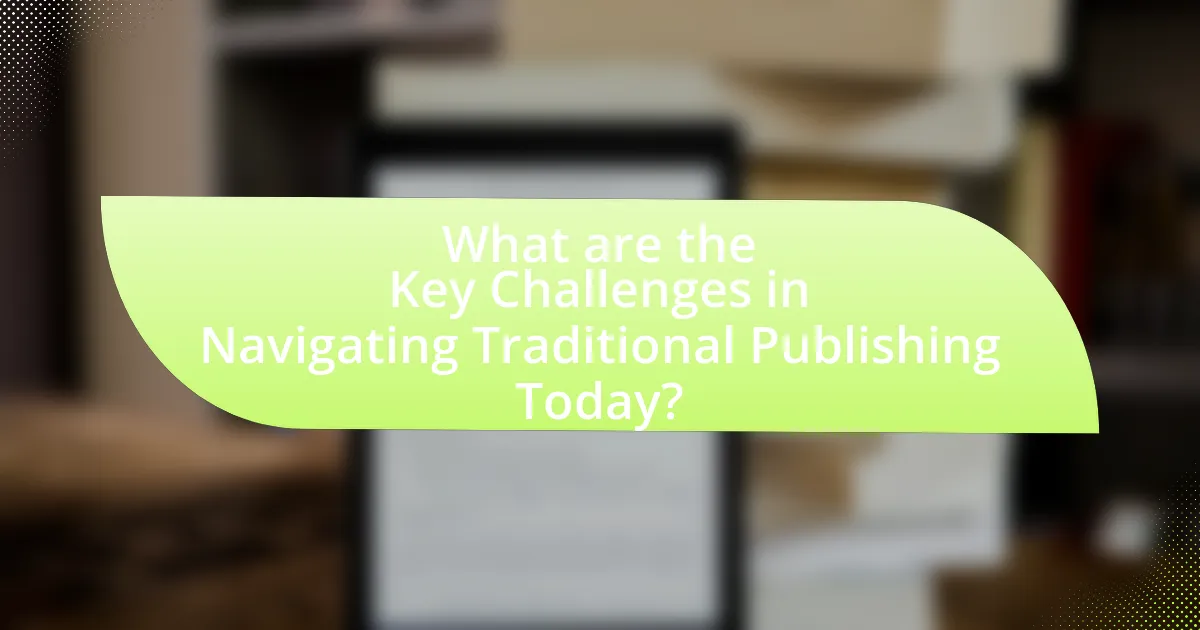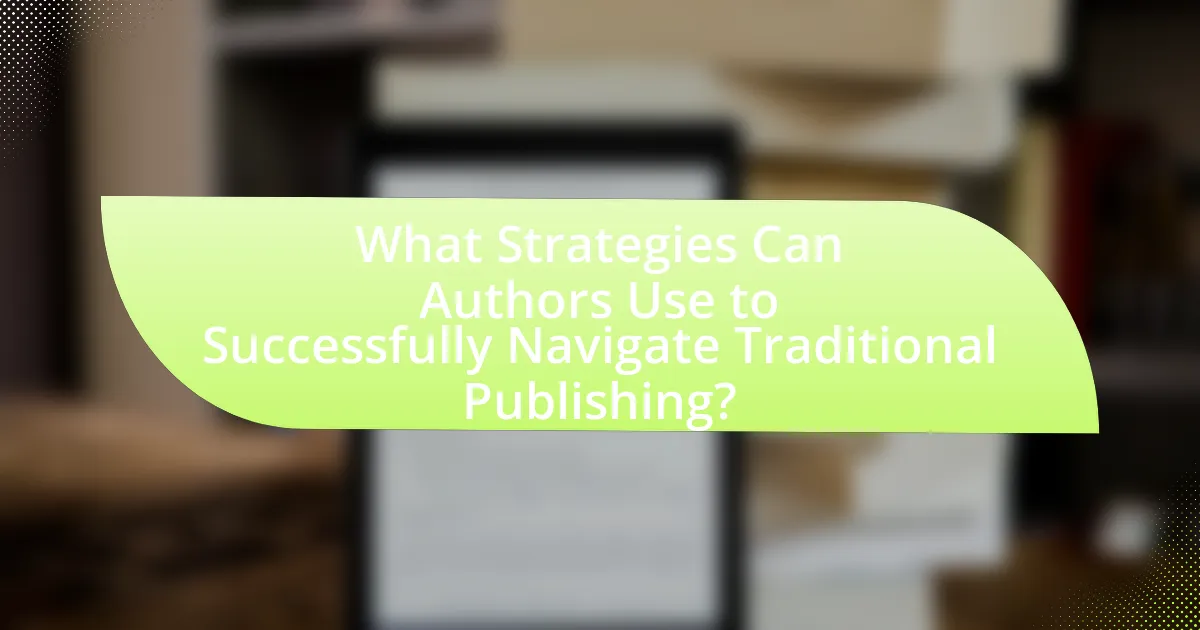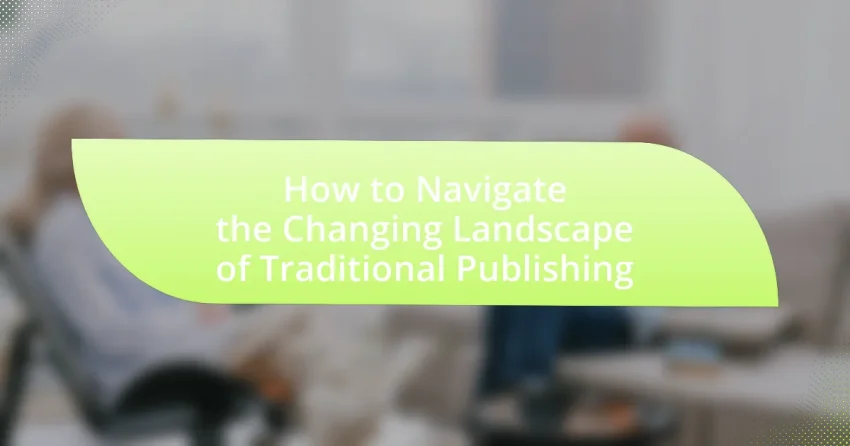The article examines the evolving landscape of traditional publishing, highlighting the impact of digital platforms, self-publishing, and changing consumer preferences. It discusses how traditional publishing has transitioned from a gatekeeping model to a more diversified environment, emphasizing the importance of technological advancements and reader engagement in shaping current trends. Key challenges faced by authors, including increased competition and the need for effective marketing strategies, are addressed, along with practical advice for navigating the publishing process successfully. The article also outlines best practices for authors to adapt to industry changes and leverage available resources for guidance.

What is the Changing Landscape of Traditional Publishing?
The changing landscape of traditional publishing is characterized by the rise of digital platforms, self-publishing, and shifting consumer preferences. Traditional publishers are increasingly adapting to the digital age, as e-books and audiobooks have gained significant market share, with e-book sales reaching approximately 20% of the overall book market in recent years. Additionally, self-publishing has empowered authors, allowing them to bypass traditional gatekeepers and retain greater control over their work, with platforms like Amazon Kindle Direct Publishing facilitating this shift. The impact of social media and online marketing has also transformed how books are promoted and discovered, leading to a more direct relationship between authors and readers.
How has traditional publishing evolved over the years?
Traditional publishing has evolved significantly over the years, transitioning from a model dominated by a few large publishing houses to a more diversified landscape that includes independent publishers and self-publishing options. In the early 20th century, traditional publishing was characterized by gatekeeping, where major publishers controlled access to the market, often prioritizing established authors and mainstream genres. However, the advent of digital technology and the internet in the late 20th and early 21st centuries disrupted this model, allowing authors to publish their works independently through platforms like Amazon Kindle Direct Publishing and CreateSpace.
This shift has led to an increase in the variety of voices and genres available to readers, as self-publishing has empowered authors to reach audiences without traditional barriers. According to a 2021 report by the Association of American Publishers, self-published titles accounted for a significant portion of the market, indicating a growing acceptance of this model. Additionally, traditional publishers have adapted by incorporating digital formats, enhancing their marketing strategies, and embracing social media to connect with readers. This evolution reflects a broader trend towards democratization in the publishing industry, where both traditional and independent routes coexist, offering diverse options for authors and readers alike.
What technological advancements have influenced traditional publishing?
Technological advancements such as digital printing, e-books, and online distribution have significantly influenced traditional publishing. Digital printing technology allows for shorter print runs and on-demand publishing, reducing costs and waste. E-books have transformed reading habits, enabling instant access to a vast array of titles and fostering the rise of self-publishing platforms. Online distribution channels, including Amazon and other e-commerce sites, have expanded market reach and changed how books are marketed and sold. These advancements have reshaped the publishing landscape, making it more accessible and efficient for authors and readers alike.
How have reader preferences shifted in the digital age?
Reader preferences have shifted significantly in the digital age towards shorter, more accessible content. This change is evidenced by the rise of mobile reading, with 70% of readers now consuming content on smartphones and tablets, leading to a preference for bite-sized articles and visual storytelling. Additionally, the popularity of audiobooks and podcasts has increased, with audiobook sales growing by 20% annually, indicating a demand for multitasking-friendly formats. These trends reflect a broader desire for convenience and immediacy in content consumption, reshaping how traditional publishing approaches audience engagement.
Why is it important to understand the current trends in traditional publishing?
Understanding current trends in traditional publishing is crucial for authors and industry professionals to remain competitive and relevant. The publishing landscape is evolving due to technological advancements, changing consumer preferences, and market dynamics. For instance, the rise of digital platforms has shifted reader engagement and purchasing behaviors, with e-books and audiobooks gaining significant market share, accounting for over 30% of book sales in recent years. Additionally, awareness of trends such as self-publishing and hybrid models can inform strategic decisions regarding manuscript submissions and marketing approaches. By staying informed about these trends, stakeholders can better adapt their strategies, optimize their outreach, and ultimately enhance their chances of success in a rapidly changing environment.
What impact do market trends have on authors and publishers?
Market trends significantly influence authors and publishers by dictating consumer preferences and shaping the publishing landscape. For instance, the rise of digital platforms has led to an increase in self-publishing, allowing authors greater control over their work and revenue. According to a 2021 report by the Association of American Publishers, e-book sales accounted for 20% of the overall book market, highlighting a shift in reader behavior towards digital formats. This trend compels traditional publishers to adapt their strategies, focusing on digital marketing and distribution to remain competitive. Additionally, market trends such as the growing demand for diverse voices and genres push publishers to diversify their catalogs, impacting the types of books that are produced and promoted.
How can awareness of these trends benefit aspiring writers?
Awareness of trends in traditional publishing can significantly benefit aspiring writers by enabling them to align their work with market demands and reader preferences. Understanding current trends, such as the rise of digital formats and the increasing importance of social media for book promotion, allows writers to tailor their submissions and marketing strategies effectively. For instance, a report by the Association of American Publishers indicates that e-book sales have consistently grown, highlighting the need for writers to consider digital-first approaches. Additionally, recognizing the shift towards diverse and inclusive storytelling can help writers create content that resonates with a broader audience, as evidenced by the increased sales of books featuring underrepresented voices. This strategic awareness ultimately enhances a writer’s chances of success in a competitive landscape.

What are the Key Challenges in Navigating Traditional Publishing Today?
The key challenges in navigating traditional publishing today include the dominance of digital media, the consolidation of publishing houses, and the evolving expectations of authors and readers. Digital media has significantly altered how content is consumed, leading to decreased print sales; for instance, e-book sales accounted for 20% of the market in 2020, reflecting a shift in consumer preferences. The consolidation of publishing houses has resulted in fewer opportunities for new authors, as major companies acquire smaller presses, limiting diversity in published voices. Additionally, authors now face heightened expectations regarding marketing and social media engagement, as traditional publishers increasingly require them to promote their own work, which can be daunting for those without prior experience in self-promotion.
What obstacles do authors face in the current publishing environment?
Authors face several obstacles in the current publishing environment, including increased competition, changing consumer preferences, and the complexities of digital publishing. Increased competition arises from the proliferation of self-publishing platforms, which has led to a saturated market where standing out is challenging. Changing consumer preferences, influenced by digital media, require authors to adapt their marketing strategies and engage with readers through social media and other online channels. Additionally, the complexities of digital publishing, such as navigating various formats and distribution channels, can overwhelm authors who are unfamiliar with technology. These factors collectively create significant hurdles for authors aiming to succeed in today’s publishing landscape.
How do changes in distribution channels affect authors?
Changes in distribution channels significantly affect authors by altering their access to readers and impacting their sales potential. For instance, the rise of digital platforms has shifted the focus from traditional bookstores to online retailers, which can increase an author’s visibility but also intensify competition. According to a 2021 report by the Association of American Publishers, e-book sales accounted for 20% of the overall book market, indicating that authors must adapt to these new channels to reach their audience effectively. Additionally, changes in distribution can influence the royalties authors receive; for example, self-publishing through platforms like Amazon allows authors to retain a larger percentage of sales compared to traditional publishing models. Thus, authors must navigate these evolving distribution landscapes to maximize their reach and revenue.
What role does competition from self-publishing play?
Competition from self-publishing significantly impacts traditional publishing by providing authors with alternative avenues to reach readers without the constraints of traditional gatekeeping. This shift has led to increased pressure on traditional publishers to adapt their business models, enhance author support, and improve marketing strategies to retain talent. According to a 2021 report by the Author Earnings project, self-published books accounted for approximately 30% of the eBook market, demonstrating the growing influence of self-publishing on reader preferences and market dynamics. As a result, traditional publishers must innovate and respond to the evolving landscape shaped by self-publishing competition.
How can authors adapt to these challenges?
Authors can adapt to the challenges of the changing landscape of traditional publishing by embracing digital platforms and diversifying their publishing strategies. By utilizing self-publishing options, authors can maintain creative control and reach wider audiences, as evidenced by the rise of platforms like Amazon Kindle Direct Publishing, which reported over 1 million titles published in 2020 alone. Additionally, authors can engage with readers through social media and online communities, fostering a direct connection that enhances their visibility and marketability. This proactive approach allows authors to navigate industry shifts effectively and capitalize on emerging opportunities.
What strategies can authors employ to stand out in a crowded market?
Authors can stand out in a crowded market by developing a unique voice and niche that resonates with a specific audience. This strategy involves identifying a target demographic and tailoring content to meet their interests and needs, which can lead to a loyal readership. For instance, successful authors often engage with their audience through social media platforms, creating a community around their work. Additionally, leveraging professional networks and participating in literary events can enhance visibility. According to a 2021 survey by the Authors Guild, 70% of authors who actively engaged with readers reported higher sales, demonstrating the effectiveness of these strategies in a competitive landscape.
How important is networking in the traditional publishing landscape?
Networking is crucial in the traditional publishing landscape as it facilitates connections between authors, agents, editors, and publishers. These relationships can lead to opportunities for representation, collaboration, and access to industry insights. For instance, a survey by the Association of Authors’ Representatives found that over 70% of literary agents prefer to work with authors who come recommended by someone they know, highlighting the significance of established networks in securing publishing deals.

What Strategies Can Authors Use to Successfully Navigate Traditional Publishing?
Authors can successfully navigate traditional publishing by building a strong platform, networking with industry professionals, and understanding the submission process. A strong platform, which includes a robust online presence and a dedicated readership, can attract the attention of agents and publishers. Networking at literary events and through social media can lead to valuable connections that may facilitate introductions to agents or editors. Additionally, understanding the submission guidelines and tailoring queries to specific publishers increases the likelihood of acceptance, as evidenced by the fact that personalized submissions have a higher success rate compared to generic ones.
How can authors effectively pitch their work to publishers?
Authors can effectively pitch their work to publishers by crafting a concise and compelling query letter that highlights the unique aspects of their manuscript. This letter should include a strong hook, a brief synopsis of the story, and relevant author credentials. Research indicates that publishers receive thousands of submissions, making it crucial for authors to stand out; for instance, a study by the Association of Authors’ Representatives found that a well-structured query can increase the chances of a request for a full manuscript by up to 50%. Additionally, authors should tailor their pitches to align with the specific interests of the publisher, demonstrating knowledge of their catalog and market trends.
What elements should be included in a compelling query letter?
A compelling query letter should include a strong hook, a brief synopsis of the work, author credentials, and a professional closing. The hook captures the reader’s attention immediately, while the synopsis provides a concise overview of the plot, themes, and target audience, typically within a few paragraphs. Author credentials establish the writer’s qualifications and relevance to the subject matter, enhancing credibility. Finally, a professional closing reiterates appreciation for the agent’s time and consideration. These elements are essential as they align with industry standards for effective communication in traditional publishing, increasing the likelihood of a positive response.
How can authors research and select the right publishers for their work?
Authors can research and select the right publishers for their work by evaluating publishers’ submission guidelines, reviewing their catalog for genre compatibility, and assessing their reputation through author testimonials and industry rankings. By examining submission guidelines, authors ensure their work aligns with the publisher’s requirements, which increases the chances of acceptance. Analyzing the publisher’s catalog helps authors identify if their genre is represented and if the publisher has successfully published similar works. Additionally, consulting author testimonials and industry rankings provides insight into the publisher’s reliability and support for their authors, which is crucial for a successful publishing experience.
What role does marketing play in traditional publishing success?
Marketing is essential for traditional publishing success as it drives visibility and sales of books. Effective marketing strategies, such as targeted advertising, author branding, and social media engagement, can significantly increase a book’s reach and readership. For instance, a study by the Book Industry Study Group found that 70% of book sales are influenced by marketing efforts, highlighting the direct correlation between marketing activities and sales performance. Additionally, successful marketing campaigns can create buzz and anticipation around a book’s release, further enhancing its chances of success in a competitive market.
How can authors leverage social media to promote their books?
Authors can leverage social media to promote their books by creating engaging content that resonates with their target audience. By utilizing platforms like Twitter, Instagram, and Facebook, authors can share snippets of their writing, behind-the-scenes insights, and interact directly with readers, fostering a community around their work. Research indicates that 77% of authors who actively engage on social media report increased visibility and sales, demonstrating the effectiveness of these platforms in reaching potential readers. Additionally, authors can collaborate with influencers and participate in relevant online discussions to further amplify their reach and establish credibility within their genre.
What are effective marketing strategies for traditional publishing?
Effective marketing strategies for traditional publishing include leveraging social media platforms, engaging in author events, and utilizing targeted email marketing campaigns. Social media allows publishers to reach a broader audience and create buzz around new releases; for instance, platforms like Instagram and Twitter have proven effective for book promotion, with 40% of readers discovering books through social media. Author events, such as book signings and readings, foster direct engagement with readers, enhancing visibility and sales. Targeted email marketing campaigns can effectively reach specific demographics, with studies showing that personalized emails can increase engagement rates by up to 29%. These strategies collectively enhance visibility, foster community engagement, and drive sales in the traditional publishing landscape.
What are the best practices for authors in the changing landscape?
Authors should prioritize adaptability, audience engagement, and digital literacy as best practices in the changing landscape of traditional publishing. Adaptability involves staying informed about industry trends, such as the rise of self-publishing and digital platforms, which have transformed how books are marketed and sold. Engaging with audiences through social media and author platforms enhances visibility and builds a loyal reader base, which is crucial in a competitive market. Additionally, developing digital literacy skills enables authors to effectively utilize tools for marketing, distribution, and reader interaction, ensuring they remain relevant in an evolving industry. These practices are supported by data indicating that authors who actively engage with their audience and leverage digital tools see increased sales and reader loyalty.
How can authors maintain resilience in the face of industry changes?
Authors can maintain resilience in the face of industry changes by continuously adapting their skills and strategies to meet evolving market demands. This adaptability includes staying informed about industry trends, embracing new technologies, and diversifying their publishing options, such as exploring self-publishing alongside traditional routes. Research indicates that authors who engage in ongoing education and networking are better equipped to navigate shifts in the publishing landscape, as they can leverage new opportunities and mitigate risks associated with changes. For instance, a study by the Authors Guild found that authors who actively participate in professional organizations report higher levels of satisfaction and success in their careers, demonstrating the importance of community and support in fostering resilience.
What resources are available for authors seeking guidance in traditional publishing?
Authors seeking guidance in traditional publishing can access a variety of resources, including literary agents, publishing industry websites, and writing organizations. Literary agents provide personalized advice and can help authors navigate the submission process, while websites like Publishers Weekly and Writer’s Digest offer articles, industry news, and tips on publishing trends. Additionally, organizations such as the Association of Authors’ Representatives and the Authors Guild provide resources, networking opportunities, and advocacy for authors, ensuring they stay informed about best practices and industry standards.
